How the second-largest soup kitchen in the U.S. handles hunger todayFood and Faith: Series focuses on church's anti-hunger workPosted Nov 8, 2017 |
|
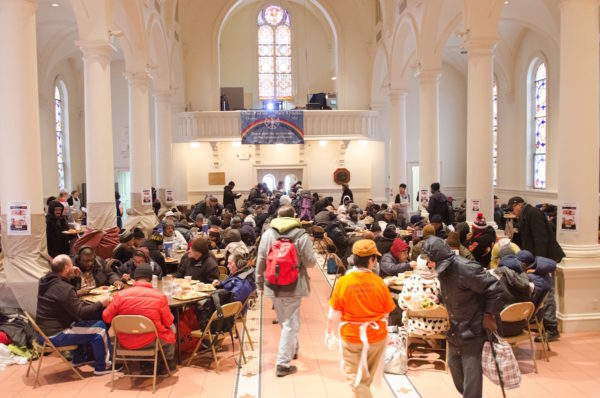
Guests can receive a free, well-balanced meal with fresh produce five days a week at Holy Apostles Soup Kitchen, which is celebrating its 35th year. The church nave can hold as many as 500 people at a time. Photo: Mike Goldsmith and Jim Graniela/Ideas in Motion
[Episcopal News Service — New York, New York] A handful of chickpeas and a few leaves of kale at lunchtime won’t change the world, but consistent, nutrient-dense meals can form the foundation for a better life. And everybody, no matter their status, deserves to enjoy delicious food, say two New York City chefs who traded in a life of linen tablecloths for one with plastic trays.
That’s why Felipé Saint-Martin left Manhattan’s award-winning, fine-dining institution, Gramercy Tavern, where the seasonal dinner tasting menu is $170 per person. His belief in providing enticing food to all people drew him to become head chef at the much humbler Holy Apostles Soup Kitchen, where the day’s main meal is free.
“Why switch?” Saint-Martin repeated as he prepared for the day’s lunch of turkey-zucchini chili over brown rice and salad made with locally grown kale and topped with cherry tomatoes, almonds, raisins, shredded carrots and ginger vinaigrette. On the side sat a slice of multigrain walnut-cranberry bread and an apple from an upstate New York farm. “The purpose.”

Chef Felipé Saint-Martin fills trays for the guests during lunch on a Tuesday in mid-July at Holy Apostles Soup Kitchen, a mission of the Church of the Holy Apostles in Manhattan. Photo: Amy Sowder/Episcopal News Service
Members of the Church of the Holy Apostles in Manhattan began the feeding ministry in 1982, when welfare benefits were slashed during the Reagan administration, with the goal of providing a warm, hearty meal to people in need. Before the soup kitchen’s director of operations, Chef Michael Ottley, arrived nine years ago, however, it was mostly about getting 2,000 calories on one tray.
“The philosophy was that was enough to sustain them for one day, but that wasn’t healthy calories,” said Ottley, a graduate of the Culinary Institute of America at Hyde Park, New York. “Eight years ago, we started concentrating on the whole person.”
That means healthy, sustainable, locally sourced meals with lean proteins, and more vegetables and fruits than protein. Volunteers serve fresh fruit and New York-farmed one-percent milk every day. But it also means serving people with dignity and providing services beyond food.
Health, harder to reach
Soup kitchens like the one at Holy Apostles are on the front lines of the Episcopal Church’s efforts to help combat hunger in America. Episcopal News Service is reporting the stories of some of those efforts for its “Food and Faith” series.
Hunger looks different in the United States, the 13th richest country in the world based on gross domestic product per capita, according to a 2017 report by Business Insider, than it does in less-wealthy nations. Rather than being skeletal or bloated from lack of food or malnourishment, Americans in need tend to be overweight and to suffer from diabetes and heart disease. That’s partly because healthy food can be more expensive and less available in poor neighborhoods, called “food deserts,” where access to supermarkets with fresh food is limited. Children grow up eating food from convenience stores, bodegas and fast-food joints – some not knowing what an eggplant or sweet potato looks like.
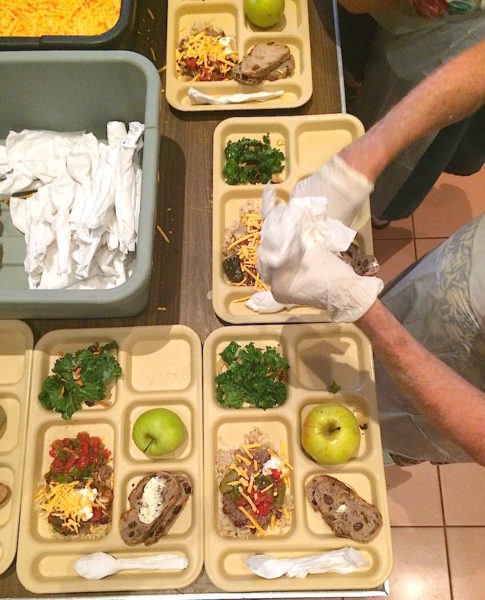
At Holy Apostles Soup Kitchen, a mission of the Church of the Holy Apostles in Manhattan, the meals contain not only the 2,000 calories recommended for a day, but more nutrients from local, fresh, and rescued food sources. Photo: Amy Sowder/Episcopal News Service
So Saint-Martin tries to create meals that include the freshest, most local ingredients available, just like Gramercy Tavern does, but with the drastically fewer resources of a not-for-profit entity. He and Ottley also want to reduce food waste and costs, help the guests’ other needs once they’ve eaten their fill, and feed more people in more ways, on more days and in more locations.
Soup kitchen rankings
‘Food and Faith’
Episcopal News Service’s five-part series focuses on anti-hunger efforts in the Episcopal Church, from food pantries to the church’s advocacy on government programs that fight hunger. Part 4 will post next week.
True, this Chelsea-based mission is the largest emergency feeding program in New York City and the second-largest in the United States, serving about 1,200 people on a busy day, Ottley said. The country’s largest soup kitchen, Project Open Hand, offers about 2,500 meals daily in San Francisco and Alameda Counties.
The biggest soup kitchen in the world? That would be the Golden Temple in the western Indian city of Amritsar, according to Al Jazeera. Every day, about 100,000 people are fed meals of roti, a flatbread, and dal, a lentil soup. The concept of free langar, the Punjab word for “kitchen,” began centuries ago with Guru Nanak, the founder of Sikh religion.
In one form or another, these emergency meals for those in need have been available around the United States since the 18th century, but the soup kitchen as we know it took hold in the Great Depression. Soup was chosen because it was economical – water could be added to serve more people.
Who needs food
Nearly 1.4 million New Yorkers face hunger every year, including almost one in four New York City children, according to City Harvest, a nonprofit organization dedicated to food rescue, distribution, and education, rescuing more than 500 million pounds of food in the city since 1982. The organization picks up day-old bread from restaurants and bakeries. Holy Apostles Soup Kitchen utilizes this bread, a lot of which comes from Eataly, an Italian eating and shopping emporium that includes a bakery, with several locations including two in Manhattan.
Even though the economy has improved the last several years, New York’s poverty and unemployment rates remain high. For many, income hasn’t kept up with the rising cost of living: 42 percent of NYC households – 2.7 million people – don’t have the income to cover basic necessities such as food, transportation, childcare, and housing, according to City Harvest.
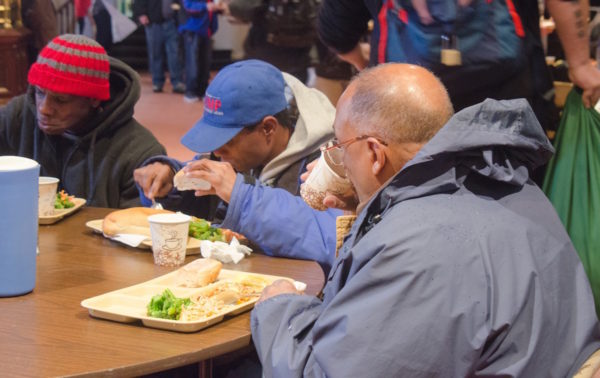
Every day, guests can enjoy fresh fruit, New York-farmed one-percent milk, lean protein and vegetables – everything locally sourced whenever possible so it’s sustainable and healthy. Photo: Mike Goldsmith and Jim Graniela/Ideas in Motion
At Holy Apostles Soup Kitchen, more than a third of the guests come from off the street, estimates the Rt. Rev. Andrew St. John, interim executive director of Holy Apostles Soup Kitchen, based on observational research. Other guests spend their nights at homeless shelters or are housed, but are working poor or are seniors from the neighborhood’s surrounding senior housing centers and facilities. “‘Guests,’ we call them. We treat people with respect. That’s very important, and we train our volunteers to do that,” said St. John, who’s originally from Melbourne, Australia, and was rector of Holy Trinity Church and The Church of the Transfiguration in Manhattan. “It’s a seamless path from love God to love your neighbor.”
In recent years, homelessness in New York City has reached the highest levels since the Great Depression, according to the Coalition for the Homeless, a not-for-profit organization that advocates for and directly serves homeless people in the city.
In May 2017, there were 61,113 homeless people sleeping each night in the New York City municipal shelter system, according to the coalition. Thousands more sleep on the streets. For families, the most common reason is lack of affordable housing and eviction. For single homeless people, especially those living on the streets, major causes are mental illness, addiction, and other health problems.
On a sunny day in Manhattan’s Chelsea neighborhood, the line starts snaking around the black wrought-iron fence an hour before doors open for the hot lunch, which is available 10:30 a.m. to 12:30 p.m. Monday through Friday. Inside, rainbows of light shoot through the multicolored stained-glass windows in the church’s nave, where the 15 round tables can seat 150 guests at a time. On Sundays, lightly cushioned chairs are brought in and placed in rows for church services.
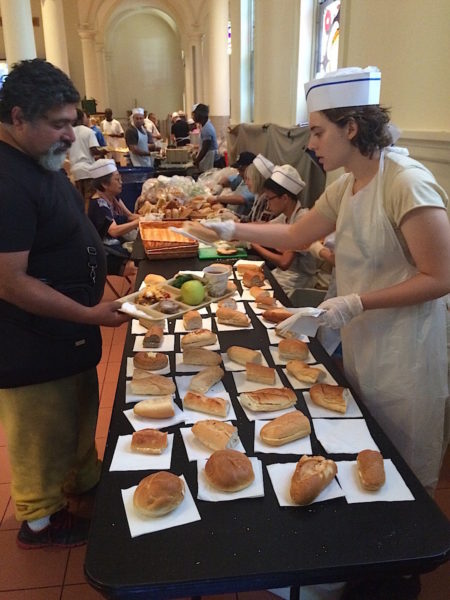
A guest at Holy Apostles Soup Kitchen, a mission of the Church of the Holy Apostles in Manhattan, accepts from a volunteer some extra buttered bread, which is offered to-go as part of the meal plan served five days a week. Photo: Amy Sowder/Episcopal News Service
“They treat you with respect. There’s some real nice people,” said Ansel, who preferred not to give his full name. Ansel eats at Holy Apostles only occasionally because he stays at a Harlem shelter that is about a two-hour commute north from the church. On this day, he was in the Chelsea area for a job interview as a cook.
Since starting at Holy Apostles nine years ago, Ottley discovered that the need is greater than ever because the expense of living in New York City is on the rise and out of reach for most people, pushing them away to the suburbs and beyond. But many people can’t afford to move. It’s a problem seen throughout the country.
“People have to decide whether they can pay for rent, medical care, or a meal,” Ottley said. “The safety net is getting full of holes. I don’t know. It’s just crazy. Are we treating our veterans right? Children? Seniors? No. These are the people who are affected the most. How do we justify that?”
The soup kitchen is feeding more seniors who don’t have enough money. Some of them come in and volunteer because they’re too embarrassed to come as guests, and it’s a good way to socialize as well, Ottley said. More Asian people are coming in too. “I don’t know why that is. Maybe it was after [Hurricane] Sandy when Chinatown was hit,” Ottley said.
The volunteers
As volunteers guide them, guests file in a few at a time to take the trays with built-in indentations for each dish. These volunteers – retirees, people doing court-ordered or school-required community service, people with disabilities, school and church groups, and corporation employees – stand behind each station donning white hats and clear gloves. The Holy Apostles Soup Kitchen has 23 full-time employees and one part-time employee, plus 55 to 70 daily volunteers.

Volunteers from mission trips help load the meal trays in assembly-line style at Holy Apostles Soup Kitchen, a mission of the Church of the Holy Apostles in Manhattan. Photo: Amy Sowder/Episcopal News Service
Edward Cohen is a volunteer coordinator who hands out assignments such as welcoming guests at the door, scooping food onto the trays, bussing tables, and collecting trays as guests leave. “I like it when school groups volunteer,” Cohen said. “They can see that there are other people less fortunate.”
Karen Lai, 16, decided to volunteer with a few friends on summer break before her junior year at Stuyvesant High School in downtown Manhattan. Lai spent her shift drying the clean trays and placing slices of that multigrain walnut-cranberry bread on each tray before sliding it to the next volunteer for the next food item, assembly-line style.
“I didn’t know what else to do, so I was like, ‘Why not?’” Lai said. “I think it’s nice that people do this and that there are a lot of volunteers willing to be here.”
What food insecurity looks like today
This mission by Holy Apostles began 35 years ago as a temporary solution to a temporary problem during former President Reagan’s tax cuts, Ottley said. “Here we are, 35 years later, still going strong, sadly, but that’s where we’re at. The United States has a real lack of food policy, and I don’t see a political climate that will change that soon,” he said.
Over the years, the soup kitchen’s mission has modernized, in part through focusing on rescued food and sustainability, which are not just marketable buzzwords about reducing food waste and keeping the economy and environment healthy in the long-term.
Saint-Martin and Ottley have dropped the cost per meal from 78 cents the first six months of 2016 to 77 cents the same time this year. The budget per meal is $1, Saint-Martin said, which has steadily dropped with their reduced costs.
This success is partly due to Ottley’s initiative to use rescued food as much as possible. The menu schedule may call for Mediterranean roasted tilapia, but if Ottley receives a load of tuna, he’s going to use that instead. On a turkey white chili day, Saint-Martin received a bunch of red kidney beans, so the chili changed. “It cuts down on the cost of food we have to pay for. I also buy directly from farmers,” Ottley said.
That helps everybody. About 1.3 billion tons of food are wasted annually, enough food to feed 3 billion people or 10 times the U.S. population for a year, Ottley said. Bananas and bread are the most wasted items.
At Holy Apostles, besides the daily bread on the meal trays, there’s a station with extra bread and butter for guests to take with them for later. And when volunteers at the trash station take the guests’ finished trays, they pluck off any untouched apples and place them in a basket for others to take if they want. Volunteers also pack 100 to 150 brown-bag lunches to deliver to bus terminals and Penn Station, part of a new program started in May.
Helping the whole person
Once a person’s basic survival needs are met, he or she can then work on thriving. Richard Trifiro, the soup kitchen’s social service manager, places trained counselors on-site to help people, one on one, find services such as job programs and referrals. Also, there are résumé workshops, job booths, meditation sessions, writing classes, ID cards, mail service, clothing banks, and toiletry stations. The biggest program is the computer workshop, Trifiro said. On Tuesdays, a screen unfurls after lunch for a movie. On this particular Tuesday, it was “Trainwreck,” a comedy starring Amy Schumer. Fun is important too.
“Food is what’s going to get them in here. Then they find concrete benefits like toiletries, clothing, and socks. It gets them engaged in the program,” Trifiro said. “Once they get past those necessities, then they’ll be more willing to do more for themselves.”
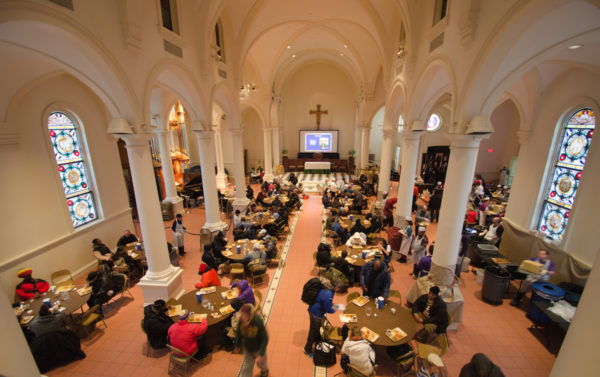
Guests can receive a free, well-balanced meal with fresh produce five days a week at Holy Apostles Soup Kitchen, which is celebrating its 35th year. The church nave can hold as many as 500 people at a time. Photo: Mike Goldsmith and Jim Graniela/Ideas in Motion
Treating people in need to delicious, nutritious food, which can fortify them to improve other aspects of life, gives Saint-Martin a sense of purpose he never had before. It’s a value he learned from his grandmother, who always provided space at the table for anyone hungry, even strangers off the street. That’s why he wanted to cook for a living in the first place.
“I think it took me 18 years to realize that. A person needs to follow their beliefs,” Saint-Martin said. “Churches need to modernize to stay relevant, and soup kitchens do that.”
— Amy Sowder is a special correspondent for the Episcopal News Service and a freelance writer and editor based in Brooklyn. She can be reached at amysowderepiscopalnews@gmail.com.

Social Menu